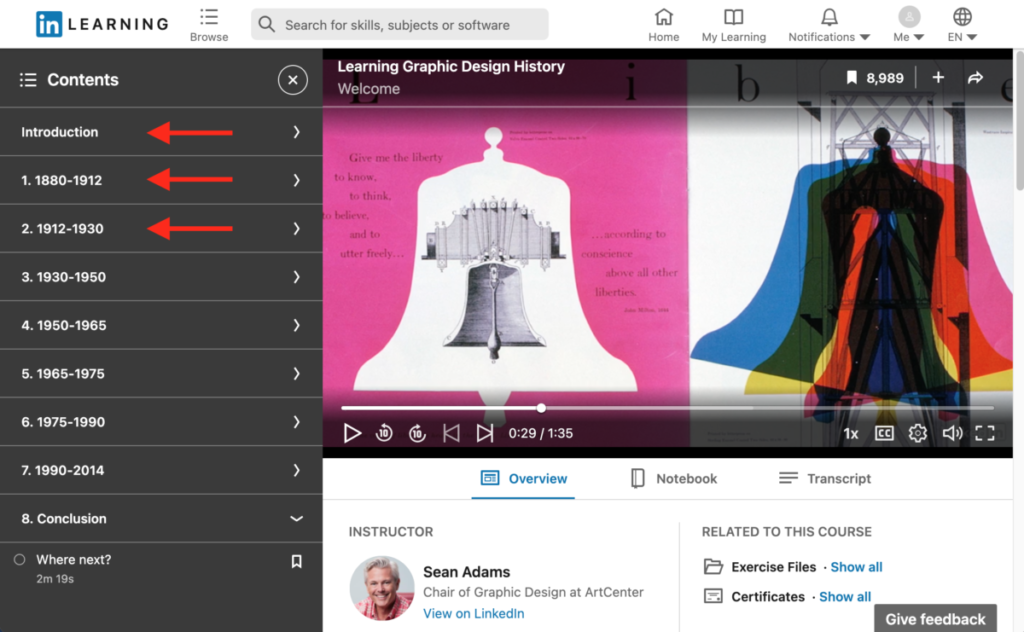Tasks Due Today
- Welcome & Introduction: Why Theory?
- Course Materials Overview
- Getting Started/Course Tools Set up
- Assignment: Reading Response 1
At the end of this session, students should have an understanding of the following:
- How to use a Public Library Card to access free LinkedIn Learning videos.
- The origins and evolution of Communication Design Theory from 1880-1930.
- Guidelines and expectations for discussion groups
- How to use Hypothesis with a downloaded PDF.
- The guidelines and due date for Reading Response 2
Activities
LinkedIn Learning with your Public Library Card
Some of the videos we will watch today and in the future are accessible via LinkedIn Learning. You can access LinkedIn Learning for free with a New York, Queens, or Brooklyn Public Library Card. Note: The Bronx and Staten Island are part of the New York Public Library system.
Use the links below for easy access to the site and the LinkedIn Learning App:
-
-
- New York Public Library Card – LinkedIn Learning Access
- LinkedIn Learning App – Library ID: nypl
- Brooklyn Public Library – LinkedIn Learning Access
- LinkedIn Learning App – Library ID: bklynlibrary
- Queens Public Library – LinkedIn Learning Access
- LinkedIn Learning App – Library ID: queenspubliclibrary
- New York Public Library Card – LinkedIn Learning Access
-
If you don’t have a Library Card, don’t worry, anyone who lives in New York State can apply for a New York Public Library Card for free and start accessing online content immediately.
-
-
- New member? Get your digital card here: www.nypl.org/library-card/new
- Expired card? Renew your card: www.nypl.org/help/library-card#renew
-
Having trouble? Don’t wait until Sunday night! Reach out to me at pchilders@citytech.cuny.edu with questions.
Laying the Groundwork for Design Theory
Review the presentation below and then take look at the graphic design history videos to help us lay the groundwork for studying design theory.
Laying the Groundwork for Design Theory
Graphic Design History Refresher
Many of you have taken the required Graphic Design History course, so please consider the following set of videos a review for the upcoming readings. If you haven’t yet taken Graphic Design History, not to worry, the videos in this series should give you an overview.
Please login to LinkedIn Learning with your Public Library Card (see above) and Locate the Course: Learning Graphic Design History. Watch the video collections: Introduction, 1880-1912, and 1912-1930 and complete the ungraded quizzes to test your knowledge.
After reading “Revisiting the Avant-Garde” and as you watch the Graphic Design History videos below, consider concepts and questions we’ve explored in Reading Response 1.
Do you notice similarities between avant-garde movements of the past and the design field (or the world) of today?
In what ways do today’s designers participate in, facilitate, or reject the following?
-
-
- Authorship
- Universality
- Social Responsibility
-
What idea(s) or concerns do you think will drive the Avant-Garde of the near future? Who will lead the charge?
Jot down some notes to share within your Discussion Groups.

If you have trouble accessing the LinkedIn Learning Course above, you can find it here on YouTube, but the quality isn’t very good and you won’t be able to access the quizzes.
Discussion Groups (30 Minutes)
Note: free sharing of ideas helps us learn and it’s also part of your participation grade.
-
- Revisiting the Avant Garde: Armstrong believes that the ambitions of avant garde artists from the early 20th century should be questioned but should inspire designers of today
- Collective Authorship is an constantly evolving aspect of design, in which the producer-consumer relationship plays a key role
- Universal Systems of Connection have been envisioned a means of uniting people through design, but remain restrictive in many ways
- Social Responsibility must be a part of the design process, as designers play a key role in shaping society
- We should ask what role the avant-garde of the new millennium will play
4. Setting up Hypothesis for offline PDFs (5 Minutes)
In addition to annotating readings hosted on a website, as we did last week, we can also collaboratively annotate PDFs that you’ve downloaded to your computer. This week you will be downloading a reading from the cloud and annotating it using the Hypothesis extension or bookmarklet.
-
- Refer to this Annotating PDFs Tutorial for instructions on how to adjust the Hypothesis Chrome Extension to allow for PDF file annotations in the browser.
- You may also use Firefox and the Hypothesis Bookmarklet
- Here’s another tutorial for downloading PDFs, viewing them in the browser, and annotating in our Hypothesis Group.
5. Assignment: Reading Response 2 (2+ Hours)
Follow these assignment guidelines: Reading Response 2 – DUE 2/21 by 6pm
You will be reading and annotating the text Hall, Sean. This Means This, This Means That: A User’s Guide to Semiotics, Laurence King Publishing, 2012 (Chapters 1 & 2) with your classmates in our Hypothesis group COMD3504_s22. Follow the instructions for annotating offline PDFs. As before, after annotating the text, create a rough draft of your response in your Research Journal. Your response should be about 200 words and checked for spelling and grammar errors. Publish your finished response on the class site, using the guidelines provided.
Resources
- Using Hypothesis / Annotating PDFs Tutorial
- Research Journal
- Assignment: Reading Response 2
- Reading Response (Example) post
Week 2 Agenda Checklist
Below are all of the tasks, big and small, for this week.
The deadline is Monday, February 22, 6 pm to allow time for review before the next agenda is posted. Successful and timely completion of these tasks will contribute to your grade.
If you have any questions, don’t hesitate to reach out: pchilders@citytech.cuny.edu



Leave a Reply
You must be logged in to post a comment.